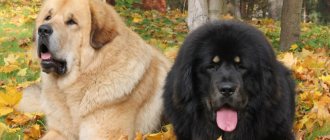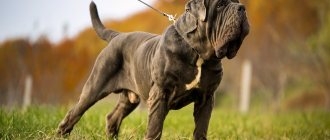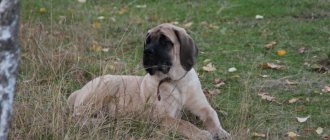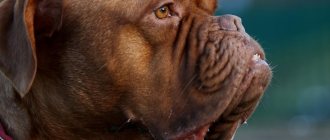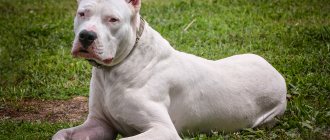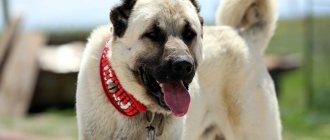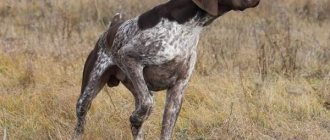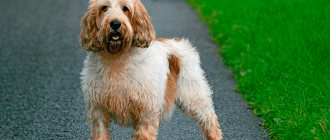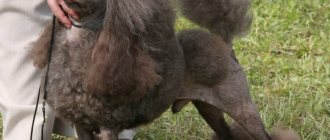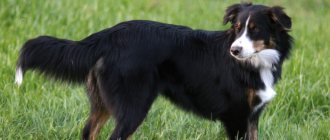Tibetan Mastiffs are large, shaggy dogs with a heavy head and a thick, lion-like mane. Despite their intimidating appearance and enormous size, they enjoy a reputation as irreplaceable helpers and faithful companions. Let's find out what Tibetan mastiffs are and what the specifics of their maintenance are.
Brief history of origin
The Tibetan Mastiff dog breed originated long before the advent of writing. Therefore, many details of its origin will remain a mystery. The approximate age of the breed was determined through genetic research at the Chinese University of Molecular Evolution. Scientists compared the mitochondrial DNA of dogs and wolves. And they determined that the first differences between them arose 42 thousand years ago. A study of the Tibetan's DNA yielded different results - 58 thousand years. This allowed us to assert that the breed is one of the oldest.
The fact that the ancestors of the modern Tibetan mastiff lived alongside humans back in the Stone and Bronze Ages is evidenced by archaeological finds in the form of fragments of skeletons and animal skulls. The first written mentions of similar dogs date back to the beginning of the 12th century. In 1121, the Chinese emperor was presented with large hunting dogs similar to a mastiff as a gift.
It is believed that the breed was bred in Tibet and was used to guard monasteries. In those days, huge, ferocious dogs were kept locked up and released only at night. Then the dogs worked together with Tibetan spaniels. The latter warned about the appearance of uninvited guests with loud barks, after which mastiffs came out to help. Huge, brave dogs could even withstand snow leopards, so monks and novices had no need to defend themselves from strangers.
Thanks to the geographical location of Tibet, representatives of the breed managed to retain their unique features for a long time. Only occasionally did they enter the territory of other states. They were presented as valuable gifts or taken out as war trophies. It is known that such dogs took part in battles along with the army of Genghis Khan, and in peacetime they performed security functions. The ancestors of modern mastiffs were also found in other ancient armies that fought against the Persians, Assyrians, Greeks and Romans.
Descriptions of a huge, ferocious dog with a booming voice and the size of a pack donkey are found in the works of Marco Polo. True, historians do not rule out that the Italian did not see the dog in person, but simply wrote down greatly exaggerated stories of other travelers.
The popularization of the breed in Europe began in 1847, when Queen Victoria received a Tibetan mastiff named Siring as a gift from the future Viceroy of India, Lord Harding. At the end of the 19th century, Edward VII brought home a couple of dogs of this breed. Later they were exhibited at an exhibition in the cultural and entertainment center of London, Alexandra Palace.
Gradually, the unique dogs became popular among the English aristocracy, and they began to be brought to Great Britain more often. Over the next 50 years, the breed spread throughout Europe.
In 1931, the Association of Tibetan Dog Breeds was organized and the first standard was developed. The author of the document was the wife of Lieutenant Colonel Frederick Bailey, who owned 4 representatives of the breed. Later, this document was taken as a basis by the International Canine Federation.
With the outbreak of World War II, the export of mastiffs from Tibet and Nepal stopped and breeders had to work hard to preserve the breed. The dogs came to the United States in 1950 as a gift to President Eisenhower. But then the Tibetan mastiffs were not appreciated and forgotten about them for almost 20 years.
In 1969, representatives of the breed were reintroduced to the United States. Just 5 years later, local dog handlers initiated the creation of the Association of American Tibetan Mastiff Lines. Over time, the organization took over the functions of the main club for breed lovers.
Photos and descriptions of colors
Standard
Black
The darkest pure black color is desirable.
Black and Tan
One of the traditional colors, called “tan” in this breed, in which there are markings of a rich reddish-fawn hue on a coal-black background above the eyes, on the inside of the tail and paws.
Blue
It can be either light, grayish-silver, or rich grayish-blue, up to the shade of wet asphalt. Medium shades are most preferred.
Blue and tan
With this color, on a blue background, there are reddish-red markings, arranged in the same pattern as on black and tan mastiffs.
Golden
The main background can be any shade from light golden to rich red.
Sable
It looks like golden, but due to the blackening of the tips of the hairs it looks more heterogeneous. At the same time, the darkening on the coat should not look like a saddle cloth.
NOTE!
With any of the above colors, small white markings on the chest and fingertips are considered acceptable.
Non-standard
In addition to standard colors, there are also those that are not officially recognized. The most famous of them are the following:
Brown
Can be of various shades of chocolate color. It is not very common and is not recognized as a standard.
Brown and tan
It is similar to the previous one, except that it has tan marks, located in the same type as in black and tan dogs.
brindle
On the main background, which has a golden, red, red or grayish tint, there are black markings in the form of stripes.
White
Considered the rarest of the breed. There are very few white Tibetan mastiffs, it is very difficult to breed them and it is for this reason that the white color is not officially recognized. At the same time, white dogs of this breed are considered, albeit non-standard, but the most expensive.
Interesting facts about the mastiff
Over the centuries-old history of the breed, a lot of interesting things have happened to it:
- Tibetan Mastiffs are considered the dogs of Buddha and Genghis Khan. Ordinary people believed that these dogs could see evil spirits. Such abilities were explained by the presence of pigment spots under the eyes of some individuals, which were considered additional pupils.
- The largest Tibetan mastiff is a dog named Shi-Lung. The height of this giant was 90 cm. After the English mastiff, he became the second largest dog on the planet. And the heaviest representative of the breed in 2014 was a dog weighing 104 kg.
- Chinese cynologists divide Tibetan mastiffs into 2 in-breed varieties - Tsang-Khi and Do-Khi. The first belong to the valley type, bred specifically for exhibitions. They have large skin folds, feathering and a thick, lush mane. The latter belong to the shepherd type and have a quieter voice. They are distinguished by their smaller size and sharp muzzle.
- The Tibetan Mastiff is not only the largest, but also the most expensive dog on the planet. In 2011, a Chinese tycoon paid $1.5 million for such a dog.
Popular varieties
The most common types of Tibetan Mastiffs are:
- Valley type , also called Tsang-Khi. These dogs are considered the most valuable and rare among representatives of their breed. They are distinguished by their massive build and great height: the height at the withers for males exceeds 75 cm, and for females - 70 cm. The most common colors are black and tan and black. These dogs were the original type of the breed; they were raised in Tibetan monasteries for thousands of years.
- Mountain Cattle Dogs or Dro-Hi. Not so large, their height ranges from 73 cm for males and 63 cm for females. The most typical colors are black, black and tan and golden fawn. Dogs of this type are widespread in Europe.
- Lion type. These dogs got their name because of the lush mane on their neck and head. They are smaller than the previous two types of mastiffs, their height ranges from 70 cm in males and 65 cm in females. Lion-type mastiffs have a slightly more elongated body and a slightly shorter muzzle. Their main colors are black, black and tan, blue, blue and tan.
- Tiger type. They are similar to “lion” dogs, but their mane is much smaller.
- Chinese type. Dogs of this type look impressive, but their breeders, primarily interested in selling puppies as expensive as possible, have long since moved away from the original type of breed. Moreover, in order to make babies look more impressive and sell better, breeders use blood from other breeds, which does not have the best effect on the temperament, character and working qualities of such dogs.
IMPORTANT!
Experts consider dogs of the valley, herding and lion types to be the most preferable and corresponding to the breed qualities developed over thousands of years.
Mastiff: breed description, standards, appearance
The Tibetan Mastiff is a large, proportionally built dog with powerful, strong bones. The breed standard according to the FCI system was developed in 1961, but now the 2015 edition of the document is considered relevant.
According to it, the standard Tibetan mastiff looks like this:
- The head is large, heavy, with a rounded skull, a pronounced stop and a wide, square muzzle. The nose is wide, with open nostrils. The shade of the lobe corresponds to the color of the coat. The jaws are strong, with a full set of teeth. Scissor bite. The lips are fleshy.
- The eyes are medium-sized, oval, slightly slanted. The iris is painted in any shades of brown.
- The ears are medium sized, triangular, hanging.
- The body is massive, with developed muscles, a muscular neck, a pronounced scruff, a straight back and a wide croup. The deep chest is formed by slightly rounded ribs and is heart-shaped.
- The limbs are strong, muscular, set parallel. The paws are round, large, with well-knit toes.
- The tail is medium length, thick, set high. Throwed on the back.
The breed standard also contains a list of serious faults. It included:
- light eyes;
- barrel ribs;
- incorrect bite;
- lightweight frame;
- tail twisted into a very tight ring;
- restricted or difficult movements;
- low-set or large ears.
Mastiff size and constitution
Tibetan Mastiffs are large dogs with moderate sexual dimorphism. The breed standard regulates only the minimum acceptable size and weight; no upper limits are set. The height of a male must be at least 66 cm at the withers, females - from 61 cm. An adult Tibetan mastiff weighs on average 60-80 kg.
On a note. Deviation from the minimum acceptable height downward by more than 2 cm is considered a serious disadvantage.
Mastiff - color and coat type
The body of the Tibetan Mastiff is covered with luxurious two-layer wool. The dog has a straight, long, hard coat and a thick, soft undercoat. The Tibetan Mastiff has developed decorative hair. There is a thick, luxurious mane on the dog’s head and neck, a dewlap on the tail, and “pants” on the back of the hind legs.
On a note. The density of the Tibetan Mastiff's undercoat depends on the region of its residence and the time of year. The warmer it is, the less dense the down.
According to the standard, the Tibetan Mastiff can have several coat color options:
- blue;
- black;
- ginger.
The color of the Tibetan Mastiff can be solid or with tan. In the latter case, golden-red markings are present on the dog’s body, and white spots are allowed on the paws and chest.
Health and life expectancy
Tibetan Mastiffs live on average 10-14 years. These dogs are endowed with good heredity and good immunity, but they also have certain health problems. The breed has a predisposition to the following diseases:
- dysplasia of the elbow and hip joints;
- osteochondrosis;
- hypertrophic neuropathy;
- entropion of the eyelid;
- ear infections;
- thyroid diseases.
Possible diseases and methods of treating them
The Tibetan Mastiff is a healthy and strong-looking dog. But does this image of him correspond to reality? Yes, it is quite. These dogs, accustomed to the cold, rarely get sick, and never get a cold. However, they do not tolerate heat very well. Due to their long coat and thick undercoat, they can become very overheated in the sun and get sick. Symptoms of heatstroke in dogs:
- Nausea or vomiting.
- Weakness.
- Limited mobility.
- Refusal to eat.
- Loss of consciousness (rare).
If you think that your pet is overheated in the sun, we recommend sending it to a cool room. Be sure to make sure that clean, cool water is freely available to him.
Finally, we point out the importance of timely vaccination. Domestic purebred dogs do not have immunity to dangerous diseases such as plague, so if they are not vaccinated on time, they risk getting sick and dying prematurely. Therefore, be sure to show your baby mastiff to the veterinarian, who will issue him a medical passport and enter information about each vaccine there.
Mastiff - character and behavior
Tibetan Mastiffs are self-confident, independent dogs with a balanced psyche and a developed sense of self-esteem. They are not characterized by such qualities as nervousness, cowardice and unmotivated aggression. Collected and independent dogs behave with dignity in any situation and do not make a fuss over trifles. They only give voice if they hear quiet knocks or rustling noises that can be regarded as a potential danger.
Tibetan mastiffs have developed guarding qualities and prefer to stay awake at night. During the day they sleep.
In the presence of their owners, huge dogs are reserved towards strangers. But if the Tibetan Mastiff feels that a threat is coming from a stranger, he instantly turns into a ferocious beast.
Dogs are very friendly towards their dogs and always try to stay closer to their owners. Tibetan Mastiffs do not tolerate separation well from their owners and may become discontented if not given enough attention.
Mastiff breed and other animals
The dominant character of the Tibetan Mastiff does not prevent the dog from getting along well with those pets he has known since childhood. But he is unlikely to make friends with unfamiliar dogs and cats.
Breed and children
Tibetan Mastiffs are great with children and love to play with them. True, due to their large size, they can inadvertently push the child or scare him.
Important! Owners of Tibetan mastiffs need to take into account that these dogs have a strong protective instinct. Therefore, if children are allowed to invite friends to the house, the dog must be isolated from them. Otherwise, the animal may perceive noisy childish fun as a threat and rush to protect its little owner.
Education and training
Due to its independent and somewhat stubborn nature, the Tibetan Mastiff is difficult to train (especially if it does not recognize the dominance of its owner). Tact and patience are your main weapons in the process of raising an animal and teaching it new commands. Avoid rude words and actions, otherwise the puppy will grow into a real problem, which will not be so easy to deal with.
The Tibetan mastiff lay down to rest and took over the entire bench
It can take about two years to fully train a Tibetan Mastiff. If you do not have enough time and experience, it is best to turn to specialists who will not only teach your dog basic commands, but also share effective tips for raising this furry giant.
An important aspect is imprinting - a set of techniques aimed at teaching an animal to unquestioningly trust its owner. Don't forget to pet the puppy and show affection. You may even have to sacrifice your own clothes for this: the mastiff loves to “chew” a person, thereby expressing his affection and desire to start another fun game. If this does not happen, and the laces on your sneakers are still intact, think about it: the puppy simply does not trust you and will not become a devoted friend in the future.
Early and proper socialization is very important for representatives of this breed. Already from the seventh week, the mastiff should be among people and other animals and thereby get used to the fact that the whole world does not revolve around his person. For the same purpose, it is recommended to invite guests to your home so that the dog gradually gets used to strangers on its territory and does not show aggression towards strangers.
When walking, you should not stick to one route. Firstly, your pet will quickly get bored and will soon stop enjoying the walk. Secondly, a change of place will allow the mastiff to understand that he does not own the whole world, and thereby make the animal more tolerant of other creatures.
Tibetan Mastiff at home
How to choose a pet
The Tibetan Mastiff is considered a rare breed, so finding the dog may cause problems. To avoid becoming a victim of scammers, such a puppy should not be bought secondhand. You should only purchase a Tibetan Mastiff from specialized nurseries or from reputable breeders.
Before purchasing, it is recommended to look at the puppies in person and ask:
- presence of documents and stamps;
- conditions of keeping the mother with the puppies;
- behavioral characteristics;
- state of health.
Pedigree Tibetan Mastiff puppies must have:
- thick paws;
- standard color;
- hanging triangular ears;
- wide square muzzle;
- thick wool.
It is also important to observe the behavior of the puppies. Small Tibetan Mastiffs should be playful, inquisitive and active.
Video about the breed
In conclusion, it is worth noting points that require attention and patience.
The Tibetan Mastiff is a difficult breed to train and requires a strong and strong-willed owner who can give the dog the required amount of attention every day. When choosing such a dog, you need to be prepared to monitor your pet’s every step for the next ten years, monitor its health, well-being and mood, and visit the veterinarian on time. Otherwise, living side by side with such a dog will bring inconvenience.
A caring owner will receive a faithful friend who will please him throughout his life.
Puppy care
It is better to adopt a Tibetan Mastiff puppy after he is 1.5-2 months old. To make it easier for your pet to cope with a change of environment, it is recommended to ask the breeder for something with the smell of its native “nest” and put it on the baby’s sleeping place. This way the puppy will calm down faster.
To make caring for a Tibetan mastiff easier and create decent living conditions for him, you need to purchase in advance:
- bedding with a replaceable cover;
- grooming tools;
- bowls for food and water;
- collar with leash;
- hygiene products;
- toys.
So that you can go for walks with your pet without fear, it is vaccinated with a complex drug:
- from plague;
- rabies;
- parainfluenza;
- leptospirosis;
- parvo and coronavirus enteritis.
The first vaccination for a Tibetan Mastiff puppy is given at 8-9 weeks with a mandatory repetition after 21 days. Subsequently, the dog is vaccinated annually. Before routine vaccination, the Tibetan Mastiff is treated against fleas and helminths.
Development of puppies by month
Tibetan Mastiff puppies develop as follows:
- 1 month. At this age, mastiff puppies look wide-faced, strong and quite well-fed. They already have a look typical of representatives of this breed and a somewhat frowning expression on their muzzle. The coat is still quite short, but already dense and dense. The babies' height is 32-28 cm, and their weight is from 3 to 4 kg.
- 2 months. The puppy begins to develop a mane, the fur becomes longer and thicker, the limbs, muzzle, ears and tail lengthen somewhat. Externally, the baby looks like a teddy bear. Its height is 30-34 cm, and its weight is 9-11 kg.
- 3 months. The fur becomes even longer and thicker, the paws even longer. At this time, the puppy may grow disproportionately: his paws may stretch too far, and his ears often seem huge compared to his head. The puppy weighs from 15 to 24 kg, and its height is 40-53 cm.
- 4 months . At this age, the puppy begins to rapidly gain height and weight. It may look a little longer-legged than before, but it is still quite strong and massive. Its height ranges from 43 to 58 cm, and its weight ranges from 20 to 33 kg.
- 5 months. Growth slows down somewhat, since the puppy’s energy needs are already somewhat reduced. He already looks almost like a smaller copy of an adult dog, except for less hair. His height is 52-60 kg, and his weight is 27-42 kg.
- 6 months. By this age, the growth of tubular bones ends and the puppy begins to grow not so much in height as in width. At six months of age, mastiffs' feathers and mane become more visible, and their muzzle lengthens and becomes more shaped like that of an adult dog. Its height is 56-65 cm, and its weight is from 31 to 48 kg.
- 7 months. The seven-month-old Tibetan Mastiff already looks very much like an adult animal, and he has already gained most of his weight. The fur is quite long and thick, the fringes on the tail and ears are already clearly visible, but the mane is still barely noticeable. Height ranges from 61 to 68 cm, and weight ranges from 33 to 51 kg.
- 8 months. At this age, the puppy already looks like an adult dog: it has the typical feathering of the breed and a small mane is visible. Height is from 63 to 68 cm, weight is about 35-55 kg.
- 9 months. The puppy looks like an adult dog, but has a lighter bone structure. Its weight is 45-57 kg, and its height is 65-68 cm.
- 10-11 months. At this age, if the puppy grows in height, it is only by a couple of centimeters, but continues to gain muscle mass, thanks to which it looks more and more impressive. His coat reaches almost the same length and thickness as that of older dogs. The puppy's weight is 49-57 kg.
- 12 months. The mastiff finally grows and in the future only gains muscle mass. Outwardly, he already looks quite impressive: he has strong bones, a well-defined mane and feathers. He weighs from 53 to 59 kg, and his height is usually 65-70 cm.
The growth of females usually stops completely or slows down with the onset of the first heat, while males grow a little longer.
Mastiff - care and maintenance
The Tibetan Mastiff is not an apartment dog. A private house with a spacious yard and a secure fence is more suitable for its maintenance. There, an indoor enclosure with an insulated booth is set up for the dog so that it can be protected from bad weather. In general, caring for a Tibetan is simple and comes down to regular hygiene, proper feeding and proper veterinary care.
Hygiene procedures
To make the Tibetan Mastiff look attractive, he is provided with proper care:
- The dog's teeth are regularly brushed with a special brush and a small amount of non-foaming toothpaste. To prevent plaque from appearing on them, the Tibetan mastiff is allowed to gnaw on large beef bones.
- The dog's eyes and ears are systematically wiped with cotton pads moistened with a special lotion or boiled water. They are also checked for infections. If heavy discharge or other suspicious symptoms are detected, the Tibetan Mastiff is taken to the veterinarian.
- A dog's nails usually wear down on their own. But if necessary, they are shortened with a nail cutter.
- Caring for the coat of a Tibetan Mastiff is not at all difficult, but requires a systematic approach. To make a dog's fur coat look aesthetically pleasing, it should be combed 2-3 times a week with a metal brush, after having been sprayed with diluted conditioner or plain water. The tangles that occasionally form on the dog’s hind legs, neck and ears are carefully removed with a tangle cutter. During shedding, the Tibetan Mastiff is scratched daily with a slicker brush or Furminator.
- Bath the dog no more than once a quarter. After bathing procedures, the Tibetan Mastiff's coat is thoroughly dried with a towel and dried with a hairdryer. More frequent washing leads to increased activity of the sebaceous glands, as a result of which the dog develops a specific dog smell.
Important! The hair of the Tibetan Mastiff is strictly prohibited from being processed with a clipper. Otherwise, the dog’s thermoregulation will be disrupted and a predisposition to pneumonia may appear.
Feeding the Mastiff
Tibetan Mastiffs need a complete, well-balanced diet. Representatives of the breed are not prone to obesity and almost never eat more than required. It is recommended to feed such dogs in a strictly designated place. It is better to place the bowl at chest level. The diet is developed individually, taking into account the age of the Tibetan mastiff:
- up to 8 weeks – 5-6 times a day;
- 2-6 months – 4 times a day;
- 6-11 months – 3 times a day;
- over 11 months – 2 times a day.
Industrial feed
Many Tibetan Mastiff breeders recommend switching their dogs to this type of food at a later age. When choosing a drying product, it is better not to save money and be sure to pay attention to the class, composition and expiration date.
The best food for Tibetan Mastiffs is premium or super premium food for giant breed dogs without soy, dyes, wheat and other unnecessary additives. The most popular products among owners of such dogs are Royal Canin, Acana and Brit Care.
Important! Tibetan Mastiffs that eat dry food must have 24/7 access to fresh drinking water.
Natural feeding
This type of nutrition is more typical for Tibetan mastiffs. In this case, the dog's diet should consist of at least 60% beef, turkey, lamb or rabbit. Meat is given to Tibetan mastiffs after preliminary processing. First, it is kept in the freezer for several days, and then scalded with boiling water and placed in a bowl. In addition to meat, it is recommended to give Tibetan mastiffs:
- eggs;
- vegetables;
- cereals;
- offal;
- dairy products;
- sea fish (without bones).
Important! During the period of active growth, Tibetan Mastiff puppies need to be given more calcium-containing foods. But vitamin-mineral complexes should be selected only after consultation with a veterinarian.
In order not to undermine the health of the Tibetan mastiff due to improper nutrition, the following are completely excluded from its diet:
- onion;
- beans;
- pork;
- tubular bones;
- confectionery;
- any human food.
Walking and exercise
Tibetan Mastiffs do not require special exercise. To get rid of accumulated energy, it is enough for them to walk outside the yard for 1.5 hours a day. Tibetan mastiffs perceive walks as an opportunity to once again communicate with their owner. And if dogs are deprived of this pleasure, they quickly develop destructive behavior.
Tibetan Mastiffs tolerate frosty and windy weather well, but have difficulty adapting to hot and humid climates. Therefore, you can walk longer with dogs of this breed in winter. And in the summer they need to be taken outside at dawn or evening hours.
Tibetan mastiff puppies are kept away from excessive exercise until they are one year old, as this can cause the development of dysplasia.
Important! Due to the huge size of the dog, walking a Tibetan mastiff cannot be trusted to a physically weak person.
Mastiff - training and education
The main characteristic of the Tibetan Mastiff is its innate stubbornness. Therefore, his training can only be entrusted to an experienced person with a strong, decisive character. In order for an adequate and controllable dog to grow from a shaggy ball, raising a Tibetan Mastiff puppy must be done from the first days of its appearance in the house.
The child is immediately set the boundaries of what is permitted and is never allowed to:
- bite;
- beg;
- climb on upholstered furniture.
With the right and systematic approach, by the age of 6 months the Tibetan Mastiff can be taught:
- come at the first call;
- do not take food from the ground or from the hands of others;
- calmly follow the owner on a leash;
- follow the commands “Sit!”, “Stand!”, “Place!” and “Lie down!”
In the process of raising a Tibetan mastiff, it is important to pay attention to its timely socialization. In order for the dog to calmly react to strong stimuli, it is introduced to other animals, children and adults, from early puppyhood. It is important that the Tibetan Mastiff learns to distinguish between a real and an imaginary threat.
Diet
The diet of the Tibetan Mastiff can be divided into two types: natural food and combined dry food.
Natural food type
Natural nutrition should be balanced, include all the necessary substances for building the body, normal metabolism, and obtaining energy. Proteins, fats, carbohydrates, microelements and macroelements, water - all these substances must enter the body in the required quantities. And you need to ensure that in addition to these substances, various toxins, bacterial and viral pathogens, or even parasites are not introduced.
From two months of age, the Tibetan Mastiff needs to be fed six times a day using the following foods:
- Dietary meat, an example of which is beef.
- Kefir.
- Cottage cheese.
- Various cereals, the best choice is buckwheat or rice.
- Eggs.
- Vegetables (boiled).
- Fruits (fresh).
- Olive oil.
- Green herbs - parsley or dill.
A veterinarian will help you choose the right diet for your dog, and he will also help you choose a special vitamin supplement.
By the sixth month of life, feeding a Tibetan should be switched to five meals a day. In addition to the above products, you can add boneless fish. An adult dog is fed two to three times a day.
The amount of food per day must be calculated based on the dog’s weight. A mastiff should eat exactly three percent of its own weight per day.
Rare gray color of the Tibetan Mastiff
Dry food
Dry ready-made food is also an excellent solution. It is balanced in micro and macroelements; no special vitamin supplement is required. A wide range from which you can choose the ideal option for each individual based on the age, gender, physiological state and financial situation of the owner.
What should you pay attention to?
- Color. High-quality food is dark brown in color and does not contain dyes or flavor enhancers.
- Meat. A high-quality food should contain at least 50% meat, since a dog is still a predator, and this type of nutrition is provided for by evolution. As a rule, this is beef or turkey, but chicken or fish are found in cheap feeds.
- Vegetables. They are considered in the composition together with cereals. A good food should contain less than 50%.
- By-products Conscientious producers indicate which by-products are used in the production of feed. The food may contain lungs, kidneys and liver. Otherwise, hooves and skins can be used.
- Dyes
Food is divided into several types - economy, elite and premium, but this does not mean that economy-class food is necessarily bad. It’s just that their energy value is much lower.
When feeding dry concentrated food, the dog must have free access to water.
Vitamins and supplements
Due to the genetic predisposition of Tibetan mastiffs to joint diseases, it is necessary to add so-called chondroprotectors to their food - supplements aimed at protecting the cartilage formations of the body. Mixtures with calcium and phosphorus are often used.
Puberty and mating
Tibetan Mastiffs become sexually mature at 6-12 months of age. But to obtain viable offspring, only those dogs that are 1.5-2 years old are allowed into breeding. For mating, fully vaccinated and healthy Tibetan mastiffs are selected, whose exterior conforms to the breed standard.
Mating is carried out on the 12-15th day from the beginning of estrus and is repeated after 1-2 days. Before mating, the dogs are not fed and they are always given time to get to know each other. If everything goes well, then a litter of 2-6 puppies will be born in due time.
Smooth-haired and long-haired
Tibetan Mastiffs can be either long-haired or smooth-haired. In everything else, except for the length of their coat, these dogs look the same.
The long-haired representatives of the breed have a thick, straight and fairly long coat, forming a thick mane around the neck, as well as feathering on the back of the limbs and on the tail.
Smooth-haired mastiffs have shorter and thicker hair, and they have almost no mane or feathering.
A trimmed longhaired mastiff can easily resemble a smoothhaired one.
Mastiff: pros and cons of the breed
Tibetan Mastiffs have not only advantages, but also disadvantages, which are best learned about at the stage of thinking about the decision to buy a puppy.
| pros | Minuses |
| Beautiful appearance | Innate stubbornness |
| Developed security qualities | Need for socialization |
| Calm character | Heavy shedding |
Expert opinion
Leonid Rodin
Experienced dog breeder
Ask a Question
Like all other Chinese breeds, the Tibetan mastiff developed for a long time in a closed area. He can be considered the standard of an aboriginal dog that has managed to preserve the character, health and habits inherent in many generations of its ancestors. The Tibetan Mastiff has two characteristics that are worth paying attention to. He is an excellent watchman and security guard, but a lazy life and the lack of need to take anyone under guardianship quickly results in laziness. The Chinese dog needs a territory, for the inviolability of which it should be held responsible. Otherwise, only the appearance will be formidable. The second point is the ineradicable instinct to hunt birds. Where this mania came from is unclear. The huge dog catches birds very quickly, and domestic chickens and ducks are of no value to him at all. If you do not take this habit under control, then during a walk the dog will only hunt, ignoring the owner’s indignation. In general, the Tibetan mastiff is of purely theoretical interest. He long ago lost the “war of four-legged animals” to smaller and unpretentious breeds. The huge size and the same appetite made this dog simply a living exhibit of a canine museum.
Where is it better to keep it, in an apartment or on the street?
On this issue, the opinions of breeders and dog handlers are divided . Some believe that a mastiff does not belong in an apartment, others do not agree with this.
In practice, there were cases when keeping a Tibet in an enclosure did not give him the proper stress, because the owners were sure that they could limit themselves to walking.
In an apartment, the animal is often allocated a part of the living space, where the dog spends most of its time . But if the owner does not pay enough attention to the animal, then Tibet will fall into depression.
The situation is similar with a private house. A mastiff should not be left unattended in the yard, as the dog needs communication. In the worst case, the animal will begin to look for company on the side or acquire the habit of digging.
IMPORTANT!
If the owner has a yard, then it is worth making sure that it is well fenced.
Dogs are rarely limited to one territory, and some even strive to climb through the fence and escape.
Tibetan Mastiff price
Tibetans belong to the group of rare and expensive breeds.
- If a puppy costs less than 50 thousand rubles, it means that it is not purebred or has serious defects.
- The cost of a purebred Tibetan mastiff varies between 70-120 thousand rubles.
- A puppy from champion parents with the prospect of a show career will cost even more. Its cost can reach 160 thousand rubles.
Tibetan Mastiffs are large, beautiful dogs with a phlegmatic temperament and strong guarding qualities. They will become loyal friends and reliable defenders of those who are ready to provide them with comfortable living conditions and proper care.
Current state of affairs
Unsuspecting of their legendary fame and popularity, large and reliable guards of the territories continue to carry out their honorable mission. They sleep nicely during the day at the feet of their owner and stand guard at night.
During their existence, fur dogs have repeatedly found friends from other canine groups, which inevitably led to some loss of purity of the breed. Real Tibetan beauties, who have all the necessary documents confirming their belonging to the mastiff elite, cost a lot of money.
There are known cases of small puppies being sold at a price of 600,000 thousand dollars. This is the highest cost of a dog cub in the entire civilized history of the globe.
When choosing a baby from a nursery, future owners need to carefully examine it. Even a mastiff puppy should have a wide and large head, somewhat disproportionate to the rest of the body.
- Newfoundland - history of the breed, education, care + 73 photos
Chihuahua - history of the breed, description, temperament, attitude towards people and animals, care + 92 photos
Brussels Griffon - history, modern appearance, standards, character and content + 77 photos
“Oriental” cut of expressive brown eyes, wide nose with large nostrils, large lower lip, thick hanging ears, velvet-covered fur. Straight posture, strong neck with thick fur, strong paws, tail set high.
All these are signs of a typical portrait of a Tibetan mastiff, your future guard and friend. Time will pass and a fierce, huge comrade will decorate any photo with a person.
But it was not external attractiveness that made this breed so rare, expensive and desirable.
Mastiffs are smart, in the process of evolution they have learned to be independent and endlessly loyal to their chosen ruler.
Next to such a friend, you and your children will feel calm, your little world will now always be under an invisible, but merciless “lock” for enemies.
Give your pet your love, attention and care, and he will return it to you a hundredfold, giving his entire huge canine heart to his family and protected area.
Tail and limbs
Thick, short hair abundantly covers the straight forelimbs with elbows strictly directed backwards. Massive pasterns, areas between forearms and paws slightly sloping. The angles on the hind limbs are well defined. The muscles on the rather long, richly feathered thighs should be strong and firm, but not lumpy. The metatarsus, the lower portions of the hind legs between the paw and the shin, are short and strong. The rounded paws are massive and large. According to the breed characteristics standard, the Tibetan Mastiff has dewclaws. The tail is of medium length, set along the line of the spine, well developed and superbly decorated with thick fluffy hair. It curls high above the back when the dog is moving or alert.
Price
In a press interview, one Chinese breeder, Zhang Gengyun, said: “Like our Chinese pandas, purebred Tibetan mastiffs are rare, which is why their prices are so high.” Perhaps this judgment does not apply to all representatives of the breed, but some of the Tibetans topped the list of the most expensive dogs on the planet. The most magnificent specimens are most often purchased by the Chinese rich, who consider the acquisition of such an animal a symbol of prestige.
In March 2011, at the annual Chinese fair in Hangzhou, Zhejiang province, a red Tibetan mastiff puppy was sold for almost two million dollars to a "coal baron" from northern China. A photo of a large Tibetan mastiff, which became the most expensive dog in history, was published by the American photo agency Getty Images. For this photo, an unknown Chinese man showed off two 11-month-old puppies, the second of which sold for one million dollars. The event was also covered by local media and the French agency France Press.
As for the white Tibetan mastiff, by 2010 there were only two individuals of this rare color living outside of China. One of the puppies was purchased for $1.2 million.
Many similar reports have been published about sales of Tibetans at astronomical prices. However, most of them were attempts by breeders to increase the selling price of their dogs. Photos shown on websites often exaggerate the color intensity, size and powerful build of the animals. By 2015, excessive and not always responsible breeding of puppies by breeders had caused flaws and multiple violations of the breed standard. The unnaturally increased size of the animals' body and mane led to this curious case: in 2013, the Chinese zoo in Luha tried to pass off a Tibetan mastiff as an African lion.
Because these dogs are too difficult to keep in urban environments, prices in China for the best of the breed have dropped to around $2,000. Today, the low quality and production of Tibetan Mastiff crossbreeds has practically stopped.
Health
These dogs rarely get sick and live long. Some individuals live up to 17 years. But there are predispositions to such diseases:
- Hip dysplasia;
- Ear infections;
- Thyroid diseases.
It should also be remembered that large breed dogs are susceptible to heart and joint diseases due to their heavy weight.
Don't forget to vaccinate your pet on time. This will protect him from many diseases that are fatal to animals. During the warm season, it is necessary to treat your dog for fleas and ticks. Once a quarter the dog is given anthelmintic.
Head
These dogs have a large skull with a pronounced occipital protuberance. The head is massive, heavy and wide, with a well-defined transition between the muzzle and the forehead, called the stop. If you measure the length from this point to the bottom of the back of the head, it will be equal to the length from the tip of the nose to the stop or slightly shorter. Dangling jowls, as well as a heavily wrinkled muzzle, are among the significant shortcomings of the breed.
The jaws of the Tibetan Mastiff are massive, with tightly spaced teeth. The ideal standard of bite is a scissor bite, but a straight bite is also possible, but underbite and overshot are unacceptable, which are considered disqualifying defects.
Oval, medium-sized eyes are widely spaced and set slightly obliquely. They must be very dark in color. The eyelids, which fit tightly to the eyeball, create a special expression of equanimity and self-dignity characteristic of these dogs.
The nose is large, the nostrils are well open. The darkest possible eye and nose color is standard. Weak pigmentation of the nose and light eyes are unacceptable characteristics in the characteristics of the Tibetan Mastiff breed.
The ears are hanging, triangular, medium in size, covered with soft short hair and pressed tightly to the head. They should be planted in the space between the conventionally drawn lines of eye level and forehead. Ears that are set low or are too large are a significant fault.
Who is this breed suitable for?
The power and beauty of this breed is both daunting and captivating at the same time. Many people would like to get such a giant as a pet. But before you get a Tibetan Mastiff puppy, you need to think carefully about this step.
This dog is suitable for owners of large houses with an impressive territory. Since the Tibetan Mastiff cannot be kept on a chain, it will need freedom to move. If you have a poorly fenced area, you will have to build a high and durable fence. It will be easy for a dog of this size to jump over a low fence or dig a hole under it. For apartment owners, even large ones, the Tibetan Mastiff will not be the best option.
You need to spend time actively with your dog. Even if you live in a private house, the dog needs to be walked outside. If you don't pay attention to your dog, it will start to get bored. In order to somehow entertain himself, the dog will begin to play dirty tricks and attract attention to himself.
Photo of Tibetan Mastiff
Raising and training this breed requires a lot of time and effort. It will take endurance and patience. Therefore, this breed is not suitable for people who are hot-tempered and aggressive, as well as too soft and compassionate. It is important for the Tibetan Mastiff to feel like a leader in its owner.
The dog will have no problems with children. She will become their big plush friend. But if there are very young children in the family, then you need to make sure that the dog does not inadvertently injure them. He may accidentally crush the baby with his body weight or knock him down.
You need to spend time caring for your dog. If you don't take care of her fur, it will get matted. They not only spoil the dog’s appearance, but also cause him inconvenience. Talk to your neighbors in advance and warn them that you are getting a Tibetan Mastiff. After all, his loud barking can disturb them. If you wake up at dawn and go to bed early, you should be prepared for the nocturnal activity of these dogs. It is in the evening that they prefer to communicate with their owners.
Fans of noisy parties will be disappointed that the dog will not share their hobbies with them. Representatives of this breed prefer silence and solitude.
Anyone who gets a Tibetan mastiff must be prepared to spend money on its food. To feed such a bear cub, you will need a high-quality diet in considerable quantities. If you already have animals, difficulties may arise. It is better to take a Tibetan Mastiff as your first pet. Or “add neighbors” to him while still a puppy.
Owner reviews
Real positive and negative reviews from the owners of these dogs will help you decide whether to get such a pet.
I can say they are adorable! There is such a lion running around our yard, there’s no other way to call it. I would like to especially note in my review the relationship with children. If I let the children go for a walk in the yard, then I don’t even worry about them, since our Baron will not allow them to go outside the gate or do mischief. He is very helpful with children and loves to play with them. I love looking at him when he’s not contentedly puffing his cheeks, it makes me feel tender. Of course, you need to tinker with the fur quite a bit, but thanks to the character qualities of this dog, I do such procedures with joy.
It took us about three years to choose the breed of dog that we would get to guard our house, which was still under construction. It’s a pity that nurseries are located only in the center of Russia, while we live better in Siberia. But this did not become a problem for us. The dog is very smart, stubborn, and calm in nature. Of course, I will especially emphasize in the review that it is not suitable for living in an apartment, but thanks to this we completed the construction of our house much faster. Masyanya became a teacher for our children, she is very patient with them, but does not let them go too far and puts them in their place on time. I think that this is the most suitable option for those who want to protect their home and family, of course, if they can afford the expensive maintenance of such a dog.
Our clumsy Barik immediately made friends with the cat, who was not very happy about the appearance of a puppy in the house. But after some time they became best friends. The dog will also never offend the neighbor's cats, which sometimes come into our yard. And with children he is absolutely golden, a real helper. I recommend this breed to everyone.
But our mastiff is two years old. And I can say that the dog is very difficult. In China there is a name for this breed. There is a dog, and there is a Tibetan mastiff. Our pet constantly tests us, he always wants to prove that he is the boss in the house. He is a miracle! We love him very much! But he is so smart and cunning that sometimes it becomes scary!
Think before you buy such a dog! They write that they are wary of strangers and are adequate in your presence. Nonsense, don't believe it! at 4 months he bit a builder on the property, he will tear anyone, I’m not kidding - he WILL TEAR. If we are talking about a dog for a family, then this is not the breed, if we are talking about guarding an object - of course yes.
Nicknames for boys and girls: what to call
Since the breed is of Chinese origin, these dogs are usually called by Chinese names.
Examples of names for girls:
- Ai,
- Bo,
- Gia,
- Lijuan,
- Meili,
- Row,
- Xiu,
- Mingzhu,
- Ting,
- Tao,
- Zhilan,
- Shihong,
- Yubi,
- Yanlin,
- Yanmei.
Names for boys:
- Bingwen,
- bojing,
- Bay,
- Weiming,
- Weisheng,
- Wenyan,
- Guangli,
- Gian,
- Zian,
- Zen,
- Kiang,
- Kingshan,
- Pengfei,
- Cheng,
- Shining.
Male: character
Advantages:
- High performance, very durable
- Solid appearance, a big plus for exhibitions
- Persistence in achieving results in the learning process
Flaws:
- Independent and more stubborn than a girl. Requires more strict training than a girl.
- To fulfill your physical and natural needs, you need a longer time for walks. According to physiology, he is not capable of quickly emptying the bladder.
- Can run away from its owner if it smells a female in heat.
- During the period of estrus in females, fights with other males are possible.
